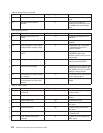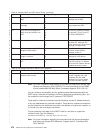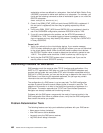3. Verify that the TCP/IP Connectivity Utilities for AS/400 product has been
properly installed on the system.
4. Look at job logs by typing “WRKSPLF QTCP” and look for any job logs with a
job name having the prefix “QTPO.” Correct any problems indicated in these job
logs.
One potential problem is that the system storage threshold has been exceeded.
Verify that this has not occurred.
Cause List B
1. If using a Client Access connection, verify the following have been properly
installed on the system:
v SS1 product, Host Servers
v XA1 product, Client Access Family - Base
v XD1 product, Client Access for Windows 95/NT
2. Verify that TCP/IP is up and running.
3. Use the NETSTAT *CNN command to verify that there is an entry in the local
port list for port 110 or “pop3.”
a. If using a Client Access IP connection, use the NETSTAT *CNN command to
verify that the as-pop3 entry exists in the local port list.
b. If using a Client Access connection, use the NETSTAT *CNN command to
verify that the following host server connections exist in the local port list:
as-signon
as-cent
as-svrmap
c. Start the Host Server using the STRHOSTSVR *ALL command. Look for
jobs that start with “QZ” in subsystem QSYSWRK to verify that host server
jobs are active.
4. If using a Client Access IPX/SPX connection, verify that an IPX job exists in the
QSYSWRK subsystem. Use the STRIPX command to start the IPX job.
v Verify that the client can “talk” to the server. Use the PING command to verify
the path from the client to the server, and the server to the client.
5. Restart the POP server using the ENDTCPSVR *POP and STRTCPSVR *POP
commands.
6. Verify that the client setup is correct. The user ID and password that the client
uses for the connection must be the same as the user profile and password on
the AS/400. Also make sure your client supports the POP protocol.
7. Verify that the user profile is enabled and that the password has not expired.
8. Ensure that the entry for the client in the system distribution directory is correct.
Each POP user needs to have a Mail service level of
System message store
and a Preferred address of
SMTP name.
Each POP user must also have an
SMTP address defined for them.
Cause List C
1. Verify that SMTP and QMSF are up and running. If not, use the STRTCPSVR
*SMTP and STRMSF commands to start them.
2. Make sure that the client entries in the system distribution directory are correct.
3. Look for any mail server framework (MSF) job logs using the WRKSPLF QMSF
command. Verify the timestamps of the logs and correct any problems
described.
Chapter 21. TCP/IP Problem Analysis 479


















